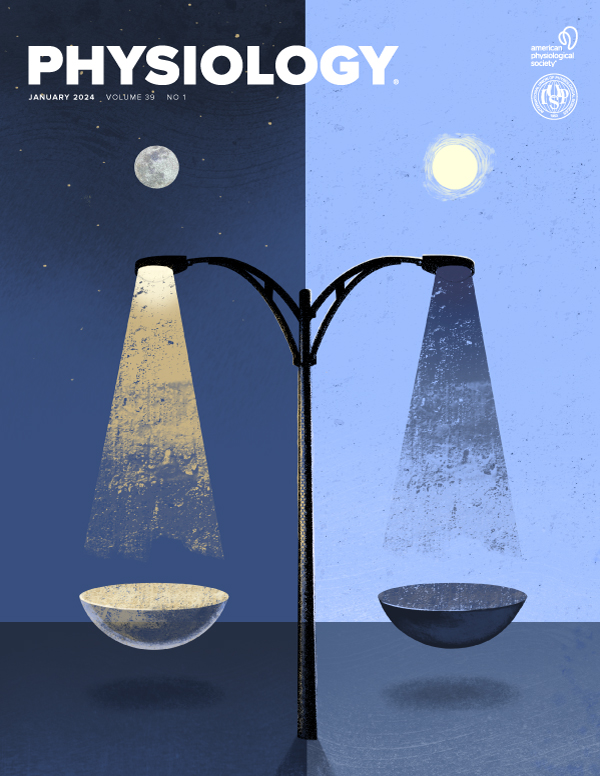在射血分数保留的心力衰竭中,交感神经对静止血压的传导得以维持
IF 5.3
2区 医学
Q1 PHYSIOLOGY
引用次数: 0
摘要
导论:在高血压和心力衰竭伴射血分数降低的患者中,交感血管收缩驱动对静息血压(BP)的传导减弱。对于具有高高血压患病率的保留射血分数(HFpEF)心力衰竭患者是否存在这种情况,目前尚不清楚。此外,尚不清楚这两种用于量化静止交感神经转导的既定方法是否能在患者群体中提供互补信息。因此,本研究的目的是全面评估HFpEF患者静息交感神经转导。我们假设HFpEF患者的交感神经传导与年龄匹配的对照组相比是迟钝的。此外,我们假设使用信号平均和线性回归斜率分析技术可以观察到HFpEF患者交感神经传导迟钝。方法:对25例HFpEF患者(70±8 (SD)岁,女性17例)和41例年龄匹配的对照组(70±6岁,女性25例;高血压患病率66%)在仰卧休息7-10分钟。在一个亚组中,使用两种分析技术评估13例HFpEF患者和15例对照组的交感神经传导到舒张压:1)信号平均在MSNA爆发后的舒张压逐次变化,其峰值变化代表交感神经传导;2)舒张压与MSNA爆发面积之间线性关系的斜率,在两个心脏周期窗口中,在每次舒张压前6-8个心脏周期的固定滞后。结果:HFpEF患者的静息血压相似(收缩压130±26 vs 126±16 mmHg, P=0.89;舒张期71±15比72±10 mmHg, P=0.64),心率增加(70±10比62±7 bpm, P<0.001), MSNA爆发频率增加(39±15比32±12次/min, P=0.06),但MSNA爆发发生率相似(55±20比51±20次/100次心跳,P=0.42)。在亚组中,当使用信号平均(Δ0.8±0.6 vs. Δ1±0.7 mmHg, P=0.45)和线性回归斜率(0.07±0.07 vs. 0.07±0.08 mmHg/%)进行评估时,HFpEF和对照组之间的交感神经转导具有可比性。s, P=0.33)方法。两种方法之间存在中度正线性关系(r2=0.39, P<0.001)。结论:与我们的假设相反,这些初步发现表明,与年龄匹配的高血压对照组相比,HFpEF患者的交感神经传导到静止血压的功能得以保留。此外,信号平均和线性回归斜率分析方法为HFpEF患者和年龄匹配对照组的静息交感神经转导提供了补充信息。在HFpEF中,生理应激源对BP的交感神经传导是否也发生了改变还有待确定。由美国国立卫生研究院(P01HL137630和R01HL091078)支持。这是在2023年美国生理学峰会上发表的全文摘要,仅以HTML格式提供。此摘要没有附加版本或附加内容。生理学没有参与同行评议过程。本文章由计算机程序翻译,如有差异,请以英文原文为准。
Sympathetic transduction to blood pressure at rest is maintained in heart failure with preserved ejection fraction
Introduction: The transduction of sympathetic vasoconstrictor drive to blood pressure (BP) at rest is blunted in patients with hypertension and heart failure with reduced ejection fraction. Whether this is the case in patients with heart failure with preserved ejection fraction (HFpEF), who have a high prevalence of hypertension, remains unknown. Furthermore, it is unclear whether the two established methods used to quantify sympathetic transduction at rest provide complementary information in patient populations. Therefore, the aim of this study was to comprehensively evaluate sympathetic transduction at rest in patients with HFpEF. We hypothesized that sympathetic transduction is blunted in patients with HFpEF compared to age-matched controls. Furthermore, we hypothesized that blunted sympathetic transduction in patients with HFpEF would be observed using both signal averaging and linear regression slope analyses techniques. Methods: BP, heart rate and muscle sympathetic nerve activity (MSNA, microneurography) were measured in 25 patients with HFpEF (70±8 (SD) years, 17 females) and 41 age-matched controls (70±6 years, 25 female; hypertension prevalence 66%) during 7-10 minutes of supine rest. In a subgroup, sympathetic transduction to diastolic BP in 13 HFpEF and 15 controls was evaluated using two analytical techniques: 1) signal averaging the beat-to-beat changes in diastolic BP following bursts of MSNA, with the peak change representing sympathetic transduction; and 2) the slope of the linear relationship between diastolic BP and MSNA burst area summed across a two cardiac cycle window at a fixed lag of 6-8 cardiac cycles preceding each diastolic BP. Results: Patients with HFpEF had similar resting BP (systolic 130±26 vs. 126±16 mmHg, P=0.89; diastolic 71±15 vs. 72±10 mmHg, P=0.64), greater heart rate (70±10 vs. 62±7 bpm, P<0.001) and a trend for greater MSNA burst frequency (39±15 vs. 32±12 bursts/min, P=0.06) but similar levels of MSNA burst incidence (55±20 vs. 51±20 bursts/100heartbeats, P=0.42) when compared with controls. In the subgroup, sympathetic transduction was comparable between HFpEF and controls when evaluated using both the signal averaging (Δ0.8±0.6 vs. Δ1±0.7 mmHg, P=0.45) and the linear regression slope (0.07±0.07 vs. 0.07±0.08 mmHg/%.s, P=0.33) methods. There was a moderate positive linear relationship between methods (r2=0.39, P<0.001). Conclusion: Contrary to our hypothesis, these preliminary findings suggest that sympathetic transduction to BP at rest is preserved in patients with HFpEF compared with age-matched hypertensive controls. Furthermore, the signal averaging and linear regression slope analyses approaches provide complementary information on resting sympathetic transduction in patients with HFpEF and age-matched controls. Whether sympathetic transduction to BP in response to physiological stressors is also altered in HFpEF remains to be determined. Supported by the National Institute of Health (P01HL137630 and R01HL091078) This is the full abstract presented at the American Physiology Summit 2023 meeting and is only available in HTML format. There are no additional versions or additional content available for this abstract. Physiology was not involved in the peer review process.
求助全文
通过发布文献求助,成功后即可免费获取论文全文。
去求助
来源期刊

Physiology
医学-生理学
CiteScore
14.50
自引率
0.00%
发文量
37
期刊介绍:
Physiology journal features meticulously crafted review articles penned by esteemed leaders in their respective fields. These articles undergo rigorous peer review and showcase the forefront of cutting-edge advances across various domains of physiology. Our Editorial Board, comprised of distinguished leaders in the broad spectrum of physiology, convenes annually to deliberate and recommend pioneering topics for review articles, as well as select the most suitable scientists to author these articles. Join us in exploring the forefront of physiological research and innovation.
 求助内容:
求助内容: 应助结果提醒方式:
应助结果提醒方式:


